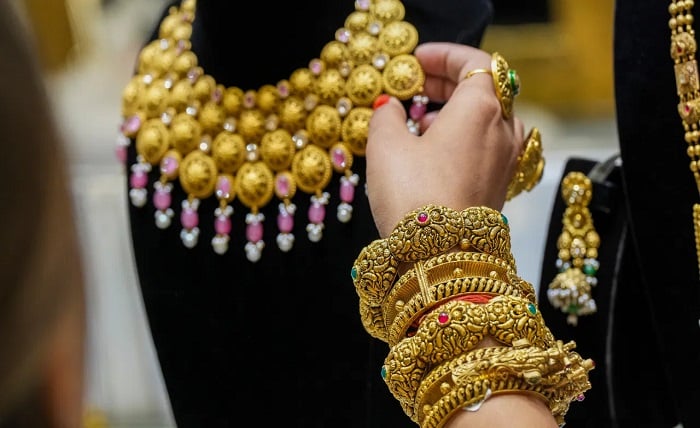The Significance of ”സ്വർണം” (Gold) in Malayalam Culture and Beyond

Gold, known as ”സ്വർണം” in Malayalam, holds an immense cultural, historical, and economic significance in Kerala and across the globe. From its symbolism in various religious rituals to its practical use in jewelry and currency, ”സ്വർണം” has always been a symbol of wealth, prosperity, and status. In this detailed blog post, we will explore the various aspects of ”സ്വർണം”, its role in Kerala’s rich cultural heritage, and its continued importance in modern society.
What is ”സ്വർണം” (Gold)?
”സ്വർണം” or gold is a precious yellow metal that has been treasured by civilizations for thousands of years. In Malayalam culture, it is revered not just as a metal of wealth but as a symbol of purity and auspiciousness. The distinct shine and luster of gold have made it desirable across generations, and its presence in both traditional and contemporary contexts in Kerala society is undeniable.
Gold is chemically inert, which means it does not tarnish or corrode over time. This unique property, along with its rarity and beauty, has contributed to its status as one of the most coveted materials in human history. It has been used in various forms, such as coins, jewelry, ornaments, and religious symbols, for thousands of years.
The Role of ”സ്വർണം” (Gold) in Kerala’s Cultural Traditions
In Kerala, ”സ്വർണം” has deep-rooted significance in both religious and cultural practices. The state’s rich traditions, which intertwine with Hinduism, Christianity, and Islam, have consistently placed gold at the center of rituals, ceremonies, and celebrations.
Gold in Hindu Temples
Kerala is known for its majestic temples, many of which have been adorned with ”സ്വർണം”. Temples in Kerala are famous for their grand festivals, which often involve offerings made in the form of gold. For instance, the famous Sree Padmanabhaswamy Temple in Thiruvananthapuram has one of the largest vaults of gold treasures, with historical accounts suggesting that the temple has been a repository of gold for centuries.
The concept of “”സ്വർണം” (gold) as an offering to deities is prevalent across Kerala’s temples. Gold is seen as a pure material that can be used to appease the gods and bring good fortune. For example, during the Onam festival, many families purchase new gold jewelry as part of the celebrations to mark the harvest season and show gratitude.
Gold and the Tradition of Wedding Jewelry
One of the most significant occasions for purchasing and gifting ”സ്വർണം” in Kerala is during weddings. Gold jewelry is an essential part of the wedding tradition in Kerala, and it is considered a vital part of the bride’s dowry. The gifting of gold during weddings is not only symbolic of the bride’s beauty but also represents prosperity and security for her future.
Jewelry such as the ”mala” (necklace), ”valaikappu” (bangle), and ”minnu” (a traditional ornament worn around the neck) are commonly exchanged during wedding ceremonies. In some communities, the bride’s family gifts gold jewelry to both the bride and her close family members. This tradition has been passed down through generations and remains a critical part of the marriage rituals in Kerala.
Gold in Festivals and Celebrations
Gold is not just reserved for weddings; it plays an important role in other festivals and celebrations in Kerala as well. During Onam, a festival that celebrates the mythical King Mahabali’s return to Kerala, families often purchase gold ornaments to wear and showcase prosperity. Similarly, gold is also a part of other festivals like Vishu, where it is customary to purchase gold as an auspicious gesture for the coming year.
The importance of gold in these cultural practices is not just due to its material value but also because it holds spiritual significance. The glimmer and brightness of gold symbolize the radiance of the gods and the blessings that come with prosperity and good fortune.
The Economic Importance of ”സ്വർണം” (Gold) in Kerala
Apart from its cultural and religious significance, ”സ്വർണം” plays a critical role in the economy of Kerala. Gold is not just a cherished item in homes and temples; it is also an essential commodity in the state’s economy.
Gold as a Store of Value
In a state like Kerala, where people often have limited access to financial institutions, gold acts as a store of value. Families accumulate gold over time, often through savings, and use it as collateral when they need loans. This is particularly true in rural areas where banking infrastructure may be limited.
Gold also serves as a form of investment for many households. During periods of inflation or economic uncertainty, people in Kerala often turn to gold as a more stable asset, as its value tends to rise over time. This is one of the reasons why Kerala has a high per capita consumption of gold compared to other Indian states.
The Gold Jewelry Market in Kerala
Kerala is home to one of the largest gold jewelry markets in India. The state’s fondness for gold can be seen in the numerous jewelry shops spread across the towns and cities. From traditional gold jewelry to modern designs, Kerala’s gold market is vast and diverse. It is estimated that the state imports a large percentage of India’s total gold imports, which further highlights the demand for gold in Kerala.
The gold jewelry market in Kerala also plays a vital role in employment generation. Many artisans, goldsmiths, and jewelers are employed in the gold industry, helping to sustain the local economy. The craftsmanship involved in creating intricate gold jewelry has been passed down through generations, and Kerala is known for producing some of the most beautiful gold ornaments in India.
Gold and Tourism
Tourism is a significant industry in Kerala, and gold plays a role in attracting tourists to the state. The state’s temples, adorned with gold statues, ceilings, and offerings, are major tourist attractions. Additionally, the vibrant gold jewelry shops draw visitors who are looking to buy authentic Kerala gold jewelry. Tourists are often attracted to the intricate designs and the quality of the gold, making it one of the state’s unique selling points in the global market.
The Symbolism of ”സ്വർണം” (Gold) in Malayali Society
Gold has always held deep symbolic meaning in Malayalam culture. It is more than just a physical commodity—it represents values such as prosperity, purity, and strength. The symbolism of gold in Malayalam society can be seen in its role in weddings, festivals, and everyday life.
Gold as a Symbol of Prosperity
In Kerala, the belief in the transformative power of gold is strong. Owning gold is often equated with owning wealth, and gold is seen as a means to secure one’s financial future. Families that own substantial amounts of gold are often viewed as prosperous and blessed. This belief stems from ancient times when owning gold was directly linked to a family’s economic status.
Gold and Purity
Gold is also symbolic of purity. It is a material that remains untarnished and does not lose its shine with time. In this sense, gold is often linked to the purity of the human soul and the sanctity of religious rituals. During major religious ceremonies, gold offerings are made to symbolize the offering of one’s pure intentions to the divine.
Gold as Strength and Status
In traditional Malayalam society, gold is not only seen as a symbol of wealth but also of strength. Those who possess gold are often considered to have the financial stability to weather difficult times. The status associated with owning gold elevates a family’s position in society, and it is often passed down through generations as a legacy of wealth and influence.
The Global Perspective of ”സ്വർണം” (Gold)
While gold holds deep cultural, economic, and symbolic importance in Kerala, it is equally significant on the global stage. Gold has been used throughout history as a form of currency, a store of value, and as a symbol of wealth. Its importance spans across continents and civilizations, influencing trade, culture, and economy worldwide.
Gold as a Global Asset
Globally, gold is regarded as one of the most secure assets for investment. It is often viewed as a hedge against inflation and financial instability. Countries with significant gold reserves use it as a way to stabilize their currencies and economies. Additionally, gold plays a critical role in global trade, with countries like India, China, and the United States being major players in the gold market.
The Jewelry Trade
Gold is central to the global jewelry market, which is worth billions of dollars annually. From engagement rings to luxury bracelets, gold’s prominence in jewelry has not waned over time. As a versatile material, gold can be molded into various designs, and its enduring appeal ensures that it remains a staple in the fashion industry worldwide.
The Role of Gold in Global Conflicts
Historically, gold has been a source of conflict and conquest. Empires have fought wars to gain control over gold mines, and countries have built their wealth by accumulating vast reserves of the precious metal. Even in modern times, the role of gold in geopolitics cannot be overlooked, as nations continue to rely on gold for economic and military security.
Conclusion
The value of ”സ്വർണം” (gold) transcends the boundaries of culture, history, and geography. In Kerala, gold represents more than just wealth—it is a symbol of prosperity, purity, and strength. Whether in the form of wedding jewelry, religious offerings, or economic investments, gold plays an essential role in the lives of Malayalis. Its importance is not just cultural but also economic, as it serves as a store of value and an asset in times of financial uncertainty.
On the global stage, gold’s significance remains just as pronounced. It continues to serve as a hedge against economic instability and as a symbol of luxury and status. Whether viewed as a material of wealth or a spiritual symbol, gold, or ”സ്വർണം”, remains a precious commodity that will continue to hold value for generations to come.
FAQs
- What is ”സ്വർണം” (gold) in Malayalam culture? In Malayalam culture, ”സ്വർണം” refers to gold, which holds immense value in religious, cultural, and economic contexts. It symbolizes prosperity, purity, and status.
- Why is gold so important in Kerala’s weddings? Gold plays a central role in Kerala’s weddings as it is seen as a symbol of wealth, prosperity, and security for the bride’s future. Gold jewelry is an essential part of the dowry and marriage rituals.
- How does gold influence Kerala’s economy? Gold plays a significant role in Kerala’s economy as both a store of value and a major commodity in the state’s gold jewelry market. It also acts as an investment tool for many families.
- What is the significance of gold in Kerala’s festivals? During festivals like Onam and Vishu, gold is bought and gifted as a symbol of prosperity and auspiciousness. Gold ornaments are often worn during these celebrations to mark new beginnings.
- How is gold perceived globally? Globally, gold is a highly valued asset that serves as a store of wealth, a form of investment, and a luxury item in jewelry. Its significance extends across cultures, influencing economies and global trade.





